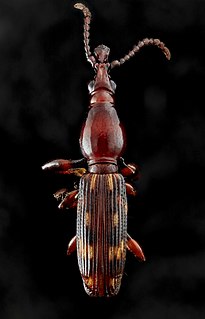 W
WArrhenodes minutus, commonly known as the oak timberworm, is a species of primitive weevil in the family Brentidae. These beetles are pests of hardwoods in North America. Adult oak timberworms are shiny, elongate, and range 7 to 25 mm in length. They are reddish-brown to brownish-black in coloration, with yellow spots on their elytra. Adults display strong sexual dimorphism; females have long, slender, straight mouthparts, while males possess flattened, broadened mouthparts with large mandibles. Males are known to be aggressive and use these large mandibles for combat. These mandibles are also used in courtship. Larvae are elongate, cylindrical, white, and curved. They have 3 pairs of jointed legs on the thorax and 1 pair of prolegs near the end of the abdomen.
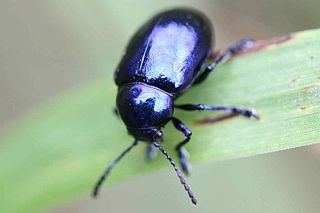 W
WChrysochus asclepiadeus is a member of the leaf beetle subfamily Eumolpinae. It is considered the type species of the genus Chrysochus, though it has sometimes been placed within the genus Eumolpus. It is the only species of Chrysochus distributed in the western Palaearctic. It is mainly found in Europe, though it is also known from Kazakhstan and Turkey in Asia.
 W
WClytra atraphaxidis is a species of leaf beetles in the subfamily Cryptocephalinae. It can be found in Southern Europe, Asia Minor, Central Asia, Mongolia and Korea.
 W
WDicronorhina micans is a species of beetle of the family Scarabaeidae and subfamily Cetoniinae. It is native to the African tropics.
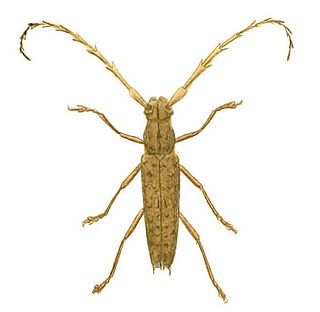 W
WElaphidion spinicorne is a species of beetle in the family Cerambycidae. It was described by Dru Drury in 1773 from Jamaica.
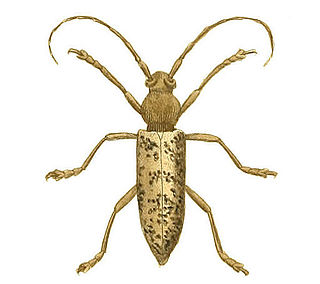 W
WEnaphalodes atomarius is a species of beetle in the family Cerambycidae. It was described by Dru Drury in 1773 from New York City.
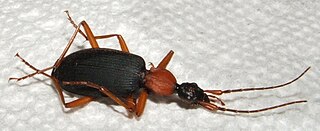 W
WGalerita bicolor is a false bombardier beetle occurring in the eastern United States. Its mimicry of the colors and shape of a bombardier beetle help it evade predators.
 W
WHarmonia axyridis, most commonly known as the harlequin, multicolored Asian, or Asian ladybeetle, is a large coccinellid beetle. This is one of the most variable species in the world, with an exceptionally wide range of color forms. It is native to eastern Asia, but has been artificially introduced to North America and Europe to control aphids and scale insects. It is now common, well known, and spreading in those regions, and has also established in Africa and widely across South America. This species is conspicuous in North America, where it may locally be known as the Halloween ladybeetle. It earns this name as it often invades homes during October to overwinter.
 W
WHoplia coerulea is a species of scarabaeid beetle belonging to the subfamily Melolonthinae. This beetle can be found in Southwest Europe, including France, Spain and Switzerland. Males are bright blue, females are brownish.
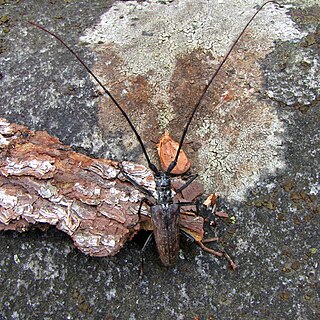 W
WMonochamus notatus, the northeastern pine sawyer or notable sawyer, is a species of beetle in the family Cerambycidae. It was described by Dru Drury in 1773, originally under the genus Cerambyx. It is known from Canada and the United States.
 W
WNeoclytus longipes is a species of beetle in the family Cerambycidae. It was described by Dru Drury in 1773.
 W
WPhryneta verrucosa is a species of beetle in the family Cerambycidae. It was described by Dru Drury in 1773, originally under the genus Cerambyx. It is known from Equatorial Guinea, and was introduced into Barbados, Grenada, and Trinidad and Tobago.
 W
WPolyrhaphis spinosa is a species of longhorn beetles of the subfamily Lamiinae. It was first described by Dru Drury in 1773.
 W
WPrionus laticollis, also known as the broad-necked root borer, is a root-boring longhorn beetle. The larvae damage trees and other plants by feeding on their roots. They are mostly active during dusk and at night. They are good burrowers and hide at the base of oak trees and other food sources. The female is larger than the male, with an ovipositor used to deposit eggs. When the female is laying eggs, she "shivers" and eggs are laid through the ovipositor, positioned down into the soil or under litter, usually in groups of threes and twos, but sometimes ones or fours. After the eggs are laid, the female moves her ovipositor up and down to fill the hole she created. When freshly laid, the eggs are pure white, glistening with moisture, but, after a while, they usually change to a deep yellow. Within a few days, the deep yellow eggs turn to a light washed pink. As the larvae develop inside, the eggs turn ivory in color. The eggs are the size of small grains of rice. When the larvae are hatching, they chew through one of the elongated, pointed sides of the egg. The larvae's heads are adapted for digging into the soil, and they have strong black mandibles for chewing roots.
 W
WProsopocera bipunctata is a species of flat-faced longhorn beetles in the subfamily Lamiinae. It was first described by Dru Drury in 1773, from Sierra Leone.
 W
WSagra femorata is a species of beetle belonging to the family Chrysomelidae.
 W
WSaperda perforata is a species of beetle in the family Cerambycidae. It was described by Pallas in 1773, originally under the genus Cerambyx. It has a wide distribution in Europe. It feeds on Populus nigra, Populus alba, and Populus tremula. It is preyed upon by the parasitoid wasp Xorides indicatorius.
 W
WSmaragdesthes africana is a species of flower beetle belonging to the family Scarabaeidae.
 W
WSteirastoma pustulata is a species of beetle in the family Cerambycidae. It was described by Dru Drury in 1773 from Jamaica.
 W
WSternotomis mirabilis is a genus of long-horned beetle belonging to the family Cerambycidae. It was first described in 1773 by Dru Drury from Sierra Leone.
 W
WSternotomis pulchra is a species of beetle belonging to the family Cerambycidae.
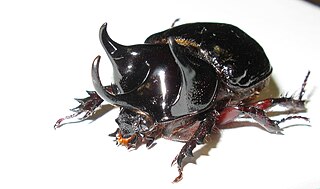 W
WStrategus antaeus, the ox beetle, is a species of rhinoceros beetle in the family Scarabaeidae.
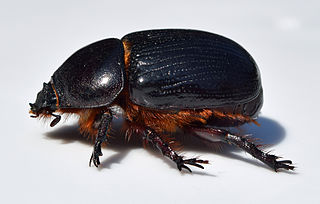 W
WXyloryctes jamaicensis, known generally as the rhinoceros beetle or unicorn beetle, is a species of rhinoceros beetle in the family Scarabaeidae. It is found in North America.